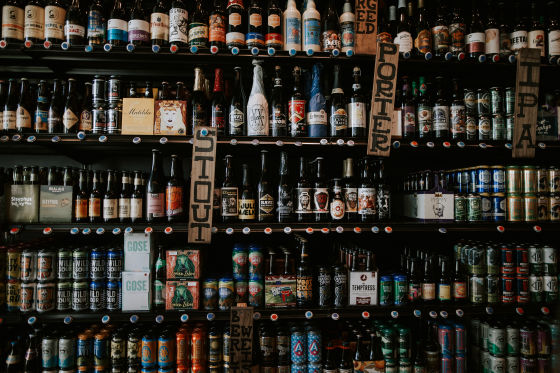What is there on the back side where the craft beer brewery got bigger than 10 years and 6 times big & popular exploded?

byMatan Segev
Despite the decline in beer sales overall in the US, the number of breweries in craft beer has increased by a factor of 6 between 2008 and 2016, and employees have also doubled. A craft beer that is so successful as to be a model for small business in the future Behind the success of business businesses, what elements are involved is explained.
Craft Beer Is the Strangest, Happiest Economic Story in America - The Atlantic
https://www.theatlantic.com/business/archive/2018/01/craft-beer-industry/550850/
Until around 2012, 90% of the American beer industryblue Moon,Pilsner Urquell,Anheuser · Bush · Inbev,CoorsThe four companies dominated. However, there is an adverse effect on the fact that industries are monopolized by strong companies. In previous research, it is because knowing that overwhelmingly powerful companies exist, innovation will not occur and workers will be harmed. In fact, despite the growing economy, employment at the brewery was on a downward trend between 2002 and 2007.
However, since 2008 to 2016 the number of breweries has increased at a pace of 120% per year. Despite the decline in beer consumption in the US, the brewery has grown more than six times in 10 years and the number of employees has also doubled.
This is a graph showing the increase and decrease in the number of beer breweries. It decreased and increased from 2001 to 2008, and although the number dropped sharply in 2008, it has since been surprisingly increased at a pace.

The number of employees of the brewery was also flat at less than 30,000 people, which was nearly 70,000 in 2017.

Beer consumption in 2017 has decreased compared with the 2000s, and prices have increased by nearly 50%. I have monopolized the industry so farA beer companyAs sales are decreasing, we can see that consumers are paying more expensive and special beer.
With the development of technology and globalization, many modern industries have been able to manufacture more efficiently than ever. However, the manufacturing of craft beer is labor-intensive and costly, and it takes a lot of people to make a small amount of beer, so at first glance the success of craft beer business seems contrary to the current wave.
So why did the craft beer industry grow quickly? That is why there are reasons from two aspects, "consumer preference change" and "law."
Brewer AssociationAccording to Bart Watson, an economist, the three reasons why craft beer became popular are three features: 'rich flavor, large variety, support of local business'. This is also occurring in industries such as casual restaurants and coffee shops, so "unusual beer" and "expensive coffee" are new trends, and one of the reasons is that things consumers demand changed. .

byNick Hillier
There is also a view that people who fall into a situation where they can not have a job due to the economic downturn have been forced to start their own businesses. And by focusing on niche markets that big companies have ignored so far, entrepreneurs have been able to pave the way.
And, looking at the history of regulations in the United States, we can see that the combination of specific rules causes innovation or decline.
Early in the 20th century, the American brewery had a directly operated bar, or was drinking alcohol at a fixed shop. Because the shops are connected to the distillery and the brewery, these are called "tied houses (tied houses / specialty pub)." Tide HouseVertical integrationBecause it is in the state, lowered the price, made patrons drunk with sake and made a flow to run gambling and prostitutes, became a big enemy of abstinence movement.
I ended the drinking prohibition lawUnited States Constitution amendment Article 21When it was issued, legislators thought that it was necessary to ban vertical integration of tide houses to encourage safe drinking. And as a result of voting, the citizens of all the provinces of the US abolished Tidehouse and agreed to separate the bar and the manufacturer. This created a system in which a manufacturer sells alcohol to an independent broker who wholesale and a broker sells to a retail store.

byChristin Hume
In addition to the fact that the rules are set for each province, the alcohol industry was intentionally designed to be inefficient and difficult to monopolize by dividing alcoholic beverages into three groups. The American beer industry was structured to keep the balance of morals.
Even in the current laws of the United States, it is basically prohibited that beer makers place gift shelves in retail stores in exchange for purchasing gifts or purchase shelf space for selling their products It is. However, there are exceptions, and for small breweries it is allowed to make supermarkets and shops. While restricting the behavior of large companies, newcomers have a mechanism to leave opportunities.
After the election of Ronald Reagan, when the Justice Department relaxed the regulation of the Antimonopoly Act, integration began in various fields including the beer industry. In the past 30 years, 48 breweries were absorbed by Anheuser · Bush · Inbu and Coors, the old system's shadow disappeared.
However, even as corporations have absorbed and merged in 30 years, the soil where the craft beer revolution was partly made little by little. In 1978, individuals were officially recognized as an act of brewing beer for small and non-commercial purposes, and a generation was born that experienced a rich and complex flavor, unlike beers made by large companies. In that trend, in the 1980s a little craft beer boom occurred. Some of the breweries born at this time have succeeded in expanding the scale to the present.
Also, most recently, several states have allowed craft beer breweries to directly sell beer to consumers and wholesale beer to the bar. This is an exceptional treatment to small breweries to the last, but with this exception there is a tendency for a small company for enthusiasts to expand the entrepreneurial business by increasing fans.

byCynthia De Luna
In other words, the lesson learned from the popularity of craft beer is that "large companies are not suitable for innovation and employment creation, and small companies create product diversity and employment." "Sometimes consumers turn away from monopoly companies for very personal reasons, especially in industries related to taste, it is easy for them to change," even though it is an economy where efficiency is sometimes inefficient The design of the system will be wise. "
The small business is small, so there is a merit that can not be immediatly built up perfectly at once. Large enterprises have the merit of massive manufacturing, high wage creation and attractive great talent, each of which has its own advantages, but the success of the craft beer industry will depend on the future business model and It is thought that there are many points to go.
Related Posts:
in Junk Food, Posted by darkhorse_log







